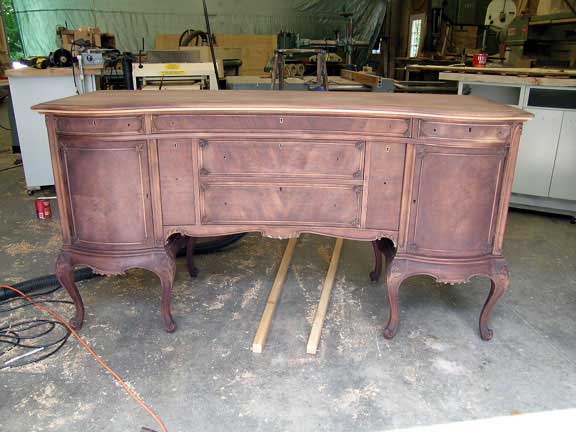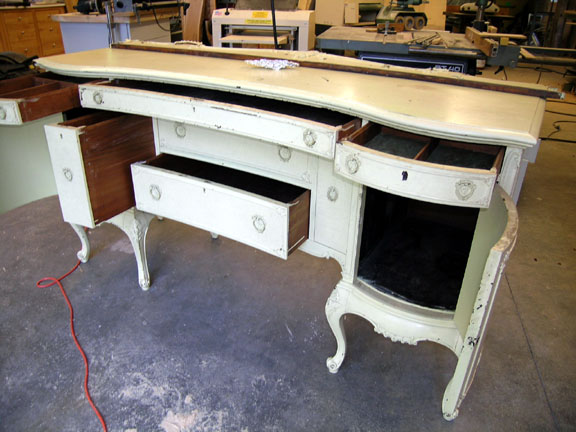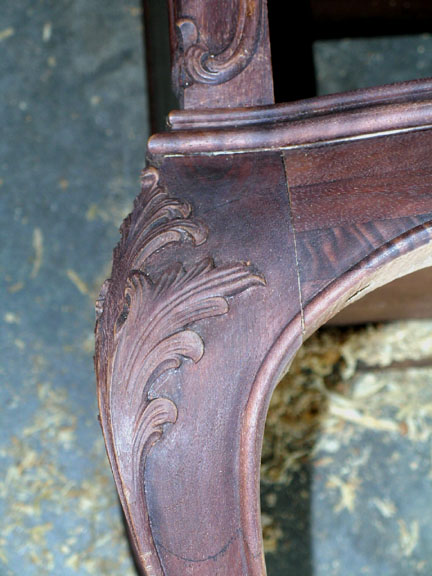Question
I am restoring a side board that was painted over the original shellac finish for a client. The finish had to be completely removed because it had been damaged and worn out in several large areas. Unfortunately, the paint bled through the old finish in several large areas (most notably the top), and was absorbed into the grain. After much stripping, scraping and sanding, I am left with a very uneven stain. So my questions are - how should I address the uneven stain situation, and secondly, what are folks thoughts about using an oil finish with Watco and wax as opposed to a built up top-coat finish? The carvings on the legs (all 8 of them) are beautiful and I feel that the oil would present them better than a film finish.

Forum Responses
(Finishing Forum)
From contributor S:
The reason you have paint in the pores is your stripping technique. There are certain ways to use chemical stripper such that you don't drive it into the grain with your scrubbing procedure. At this point you are in a fair amount of trouble and very easily could get a lot worse. You're already trying to scrape and sand your way out of it and that's the wrong way to go. Now your base color is uneven where you've been sanding excessively, so now you will need to sand the rest of the piece in similar fashion to even it up.
That is not the end of the world, assuming you don't sand through the veneer, because the base color can be replaced with a proper dye stain. However if you have paint driven into the wood pores, this is a potential deal killer. You either have to get it out, or attempt to hide it with heavy stains and toners.
I would suggest you find a reputable refinish shop and either farm this job over to them or at least get them to strip it for you. They have the equipment and experience to hopefully get that paint out of the grain and then you have a chance of pulling this out. Perhaps an experienced pro refinisher, who does the stripping for you, might also help you formulate a color and finish schedule.
I think Watco and Wax isn’t the best choice for a piece like this. #1 it is a veneered piece and if the veneer is not finished with a properly applied film finish it will lead to veneers loosening and peeling.
Watco is not a film finish and wax is a weak one. Once you put wax to this piece, you almost sign the death warrant for anyone who would later try to fix what you did. I could list a lot of other reasons but that should be enough.
I don't mean to be picky, but from the picture and what you wrote, it seems you are into something that is way outside your experience and ability. I hope you will consider calling a professional and pay them to either take over the project, or at least consult with you to formulate a plan that would approach some level of decency and keep you from ruining beyond repair what has potential to be a really fine looking piece.

Next, mix two parts lacquer thinner and one part denatured alcohol. You're going to use this as a wash over the whole piece. Dip a maroon Scotchbrite pad into the wash mix and then on the piece. Scrub the whole piece down in this fashion.
After you've done that, mix up some more of the same mix that is clean. Wash down again, this time using soft cotton rags. Keep repeating this until you can see the rinse is not removing anything. Let it dry for a few hours
Sand only what is necessary to even up the color, but generally whatever you do in one place, will need to do all over. Use an appropriate dye color to obtain a base color that you want. If you don't know about dyes, you can go to homesteadfinishing.com and you will find material and instruction. Following the dye, a pigment stain may or may not be appropriate, depending on the color desired.
A professional shop would build a nice filled or nearly filled grain lacquer finish. If it was important to be in keeping with the original system it should be a shellac finish. If you do not have spray equipment, a brushed varnish finish would get an acceptable result. A non-polyurethane varnish would be preferred.
How about the edge details and moldings - are they Mahogany or made of softwood? The doors look to have a 4 piece veneer lay-up to them. These are signs of a pretty nice piece of furniture even if found on the side of the road and I think it deserves a higher quality of finish than just a wipe on and wipe off type. Some finish options for consideration are a French polish or an oil varnish or even a piano type finish using paste wood fillers, analine dyes, and sufficient coatings which produce a full fill finish.
The case is made of maple. The door and drawer fronts are poplar with a mahogany veneer. The top is also poplar with mahogany veneer and 2" solid mahogany banding to hide the poplar. The plan now is to follow Contributor S's recommendations for cleaning and prep, then dye, stain if necessary, seal, and finally lacquer. The more I work on this piece the more I like it.
The owner suggests that it's pre 1930's (I'd agree because it does seem to be a production piece, and the use of shellac in production was all but eliminated by 1930). Does anyone have any information about its age/origin or manufacturer? Finally - I've searched high and low to find a source for replacement trim pieces and have not yet found one. Does anyone have any suggestions?
